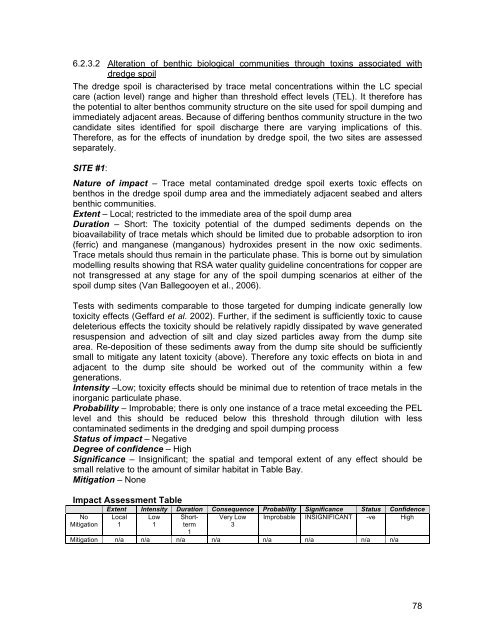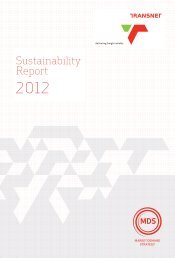BEN SCHOEMAN DOCK BERTH DEEPENING Specialist ... - Transnet
BEN SCHOEMAN DOCK BERTH DEEPENING Specialist ... - Transnet
BEN SCHOEMAN DOCK BERTH DEEPENING Specialist ... - Transnet
Create successful ePaper yourself
Turn your PDF publications into a flip-book with our unique Google optimized e-Paper software.
6.2.3.2 Alteration of benthic biological communities through toxins associated with<br />
dredge spoil<br />
The dredge spoil is characterised by trace metal concentrations within the LC special<br />
care (action level) range and higher than threshold effect levels (TEL). It therefore has<br />
the potential to alter benthos community structure on the site used for spoil dumping and<br />
immediately adjacent areas. Because of differing benthos community structure in the two<br />
candidate sites identified for spoil discharge there are varying implications of this.<br />
Therefore, as for the effects of inundation by dredge spoil, the two sites are assessed<br />
separately.<br />
SITE #1:<br />
Nature of impact – Trace metal contaminated dredge spoil exerts toxic effects on<br />
benthos in the dredge spoil dump area and the immediately adjacent seabed and alters<br />
benthic communities.<br />
Extent – Local; restricted to the immediate area of the spoil dump area<br />
Duration – Short: The toxicity potential of the dumped sediments depends on the<br />
bioavailability of trace metals which should be limited due to probable adsorption to iron<br />
(ferric) and manganese (manganous) hydroxides present in the now oxic sediments.<br />
Trace metals should thus remain in the particulate phase. This is borne out by simulation<br />
modelling results showing that RSA water quality guideline concentrations for copper are<br />
not transgressed at any stage for any of the spoil dumping scenarios at either of the<br />
spoil dump sites (Van Ballegooyen et al., 2006).<br />
Tests with sediments comparable to those targeted for dumping indicate generally low<br />
toxicity effects (Geffard et al. 2002). Further, if the sediment is sufficiently toxic to cause<br />
deleterious effects the toxicity should be relatively rapidly dissipated by wave generated<br />
resuspension and advection of silt and clay sized particles away from the dump site<br />
area. Re-deposition of these sediments away from the dump site should be sufficiently<br />
small to mitigate any latent toxicity (above). Therefore any toxic effects on biota in and<br />
adjacent to the dump site should be worked out of the community within a few<br />
generations.<br />
Intensity –Low; toxicity effects should be minimal due to retention of trace metals in the<br />
inorganic particulate phase.<br />
Probability – Improbable; there is only one instance of a trace metal exceeding the PEL<br />
level and this should be reduced below this threshold through dilution with less<br />
contaminated sediments in the dredging and spoil dumping process<br />
Status of impact – Negative<br />
Degree of confidence – High<br />
Significance – Insignificant; the spatial and temporal extent of any effect should be<br />
small relative to the amount of similar habitat in Table Bay.<br />
Mitigation – None<br />
Impact Assessment Table<br />
No<br />
Mitigation<br />
Extent Intensity Duration Consequence Probability Significance Status Confidence<br />
Local Low Shortterm<br />
Very Low Improbable INSIGNIFICANT -ve High<br />
1 1<br />
3<br />
1<br />
Mitigation n/a n/a n/a n/a n/a n/a n/a n/a<br />
78

















